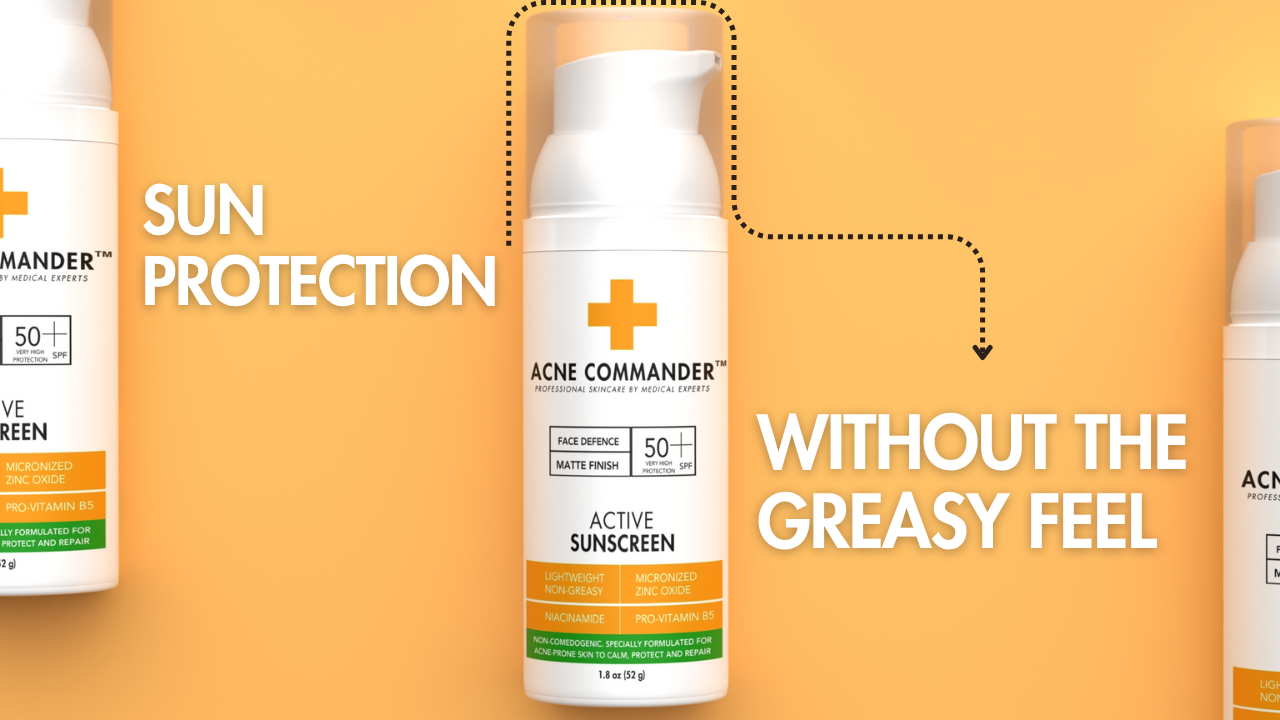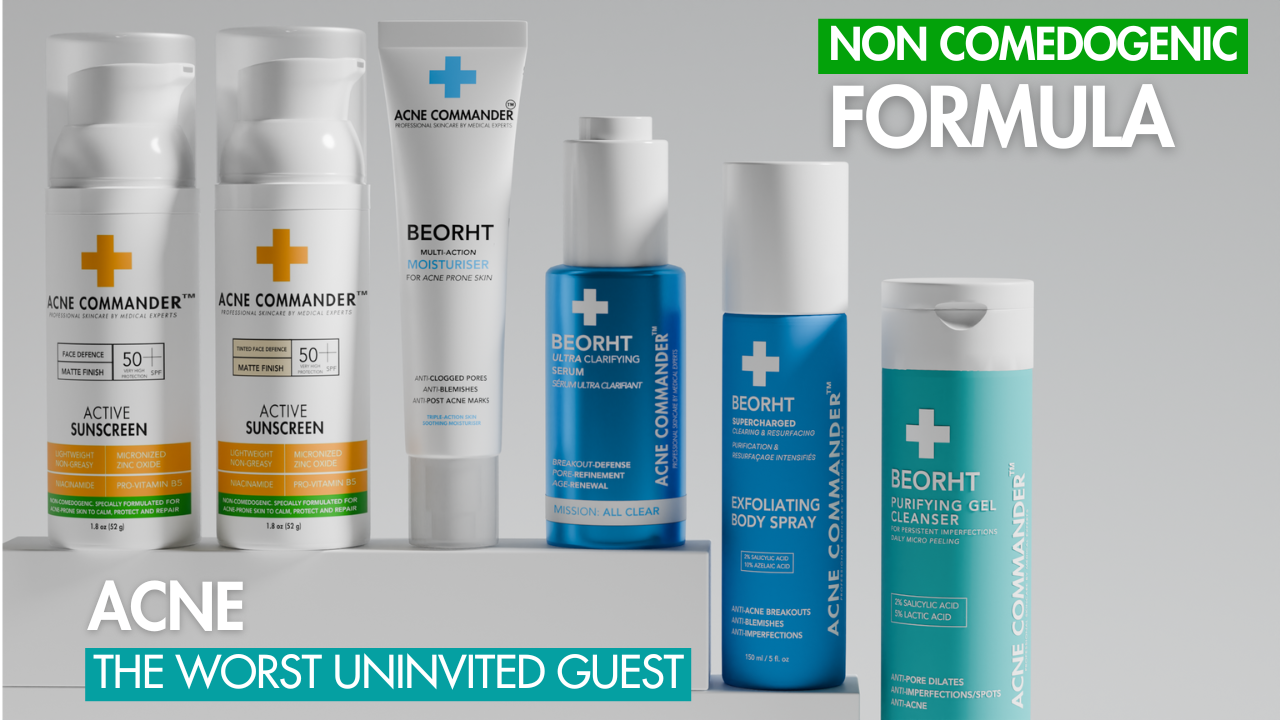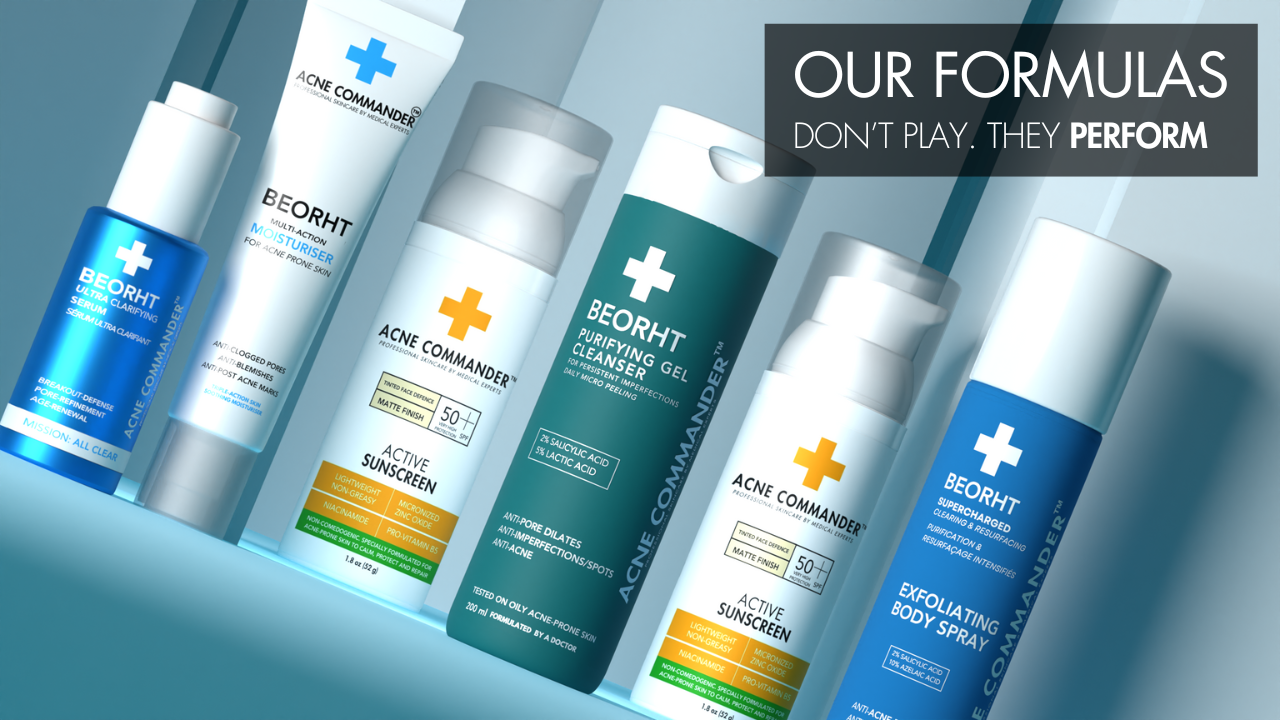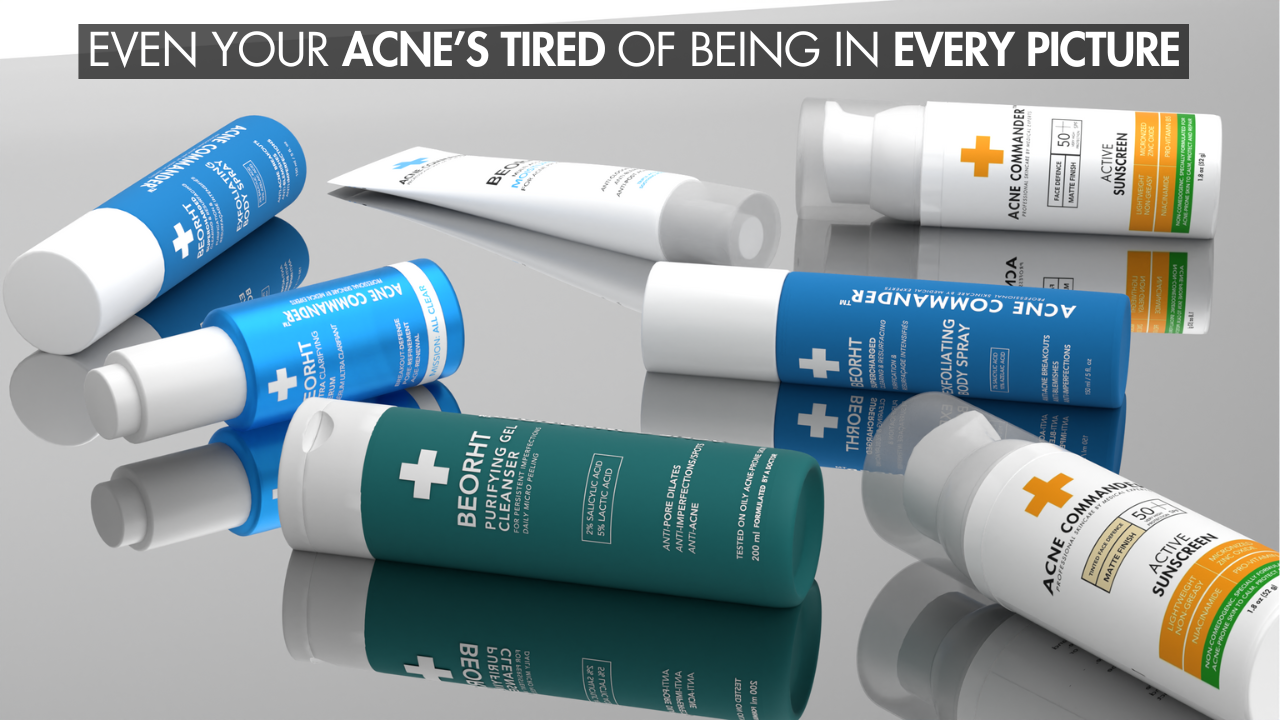Introduction
A clarifying cleanser is a highly effective product designed to remove impurities, excess oil, dirt, and buildup from the skin’s surface. Clarifying cleansers are especially beneficial for individuals with oily or acne-prone skin, as they help to deeply cleanse pores, prevent clogged pores, and control oil production. But when and how should you incorporate a clarifying cleanser into your skincare routine?
Using a clarifying cleanser the right way can make a significant difference in achieving clearer, smoother skin without over-drying or irritating the skin. In this article, we’ll guide you through the process of effectively incorporating a clarifying cleanser into your skincare routine, how often to use it, and the benefits it offers for maintaining clear and balanced skin. We’ll also highlight Acne Commander’s Beorht Purifying Gel Cleanser, a great option for anyone looking to manage acne while keeping their skin healthy.
What is a Clarifying Cleanser?
A clarifying cleanser is a deep-cleansing product that targets the removal of excess oil, impurities, and dead skin cells that can clog the pores. These cleansers are designed to offer a deeper clean compared to regular cleansers and are typically formulated with acne-fighting ingredients like Salicylic Acid, Glycolic Acid, or Benzoyl Peroxide. Clarifying cleansers work by:
-
Removing excess oil: This helps control oily skin and reduces the likelihood of clogged pores, blackheads, and acne breakouts.
-
Deeply cleansing the pores: By clearing out dead skin cells, dirt, and makeup, they help keep the pores free from blockages.
-
Exfoliating the skin: Many clarifying cleansers contain exfoliating ingredients that help slough off dead skin cells, preventing clogged pores and promoting skin renewal.
Clarifying cleansers are typically used as a first step in a skincare routine, preparing the skin for treatment products like serums or moisturizers.
Benefits of Using a Clarifying Cleanser
Incorporating a clarifying cleanser into your skincare routine offers several key benefits, particularly for oily, acne-prone, or congested skin:
1. Deeply Cleanses and Clears Pores
A clarifying cleanser works deep inside the pores to break down oil, dirt, and debris that can lead to acne and other skin concerns. By removing these impurities, it helps keep the pores clear, preventing blackheads, whiteheads, and breakouts.
2. Controls Excess Oil
Clarifying cleansers are often formulated with ingredients like Salicylic Acid or Witch Hazel, which help control excess oil production. By reducing oil on the skin’s surface, these cleansers help keep the skin from becoming too shiny and prevent clogged pores, which are a primary cause of acne.
3. Exfoliates and Brightens the Skin
Clarifying cleansers that contain exfoliating ingredients like Salicylic Acid or Glycolic Acid help to gently exfoliate the skin. This promotes cell turnover, removes dead skin cells, and improves skin texture, leaving the skin smoother, brighter, and more even-toned.
4. Prevents Acne and Breakouts
By keeping the pores clean and controlling oil production, clarifying cleansers help prevent the formation of acne, blackheads, and whiteheads. Regular use of a clarifying cleanser can help reduce the frequency and severity of breakouts.
5. Refreshes and Revitalizes the Skin
Clarifying cleansers often have a refreshing, cooling effect that revitalizes the skin. They leave the skin feeling clean, fresh, and balanced, which is especially helpful for oily skin that tends to feel greasy or congested throughout the day.
Explore detailed information for Acne Commander's Beorht Purifying Gel Cleanser. Click Here
How to Incorporate a Clarifying Cleanser into Your Skincare Routine
Now that you understand the benefits of a clarifying cleanser, let’s discuss how to effectively incorporate it into your daily skincare routine. The goal is to maximize the benefits of the cleanser without over-drying or irritating the skin.
1. Use the Clarifying Cleanser Twice a Day
For the best results, use a clarifying cleanser twice a day, once in the morning and once at night. Cleansing your skin in the morning removes the excess oil and impurities that build up overnight. Cleansing at night removes makeup, dirt, oil, and pollutants accumulated throughout the day.
-
Morning: Use the clarifying cleanser to remove excess oil and prepare the skin for the rest of your skincare routine. Follow with a toner, serum, and moisturizer.
-
Night: Use the clarifying cleanser to thoroughly cleanse the skin after a day of wearing makeup or sunscreen. This ensures that your pores remain clean and free from dirt or oil buildup, which can lead to breakouts.
2. Avoid Over-Cleansing
While it’s essential to cleanse twice a day, over-cleansing can irritate the skin and strip it of its natural oils. This can lead to dryness, irritation, and an imbalance in oil production, which may trigger more breakouts. If you feel your skin becoming tight or dry after cleansing, reduce the frequency of use.
-
Tip: If you have sensitive or dry skin, you may want to limit the use of a clarifying cleanser to once a day (preferably at night). You can alternate with a gentler cleanser in the morning.
3. Follow Up with a Moisturizer
After using a clarifying cleanser, always follow up with a non-comedogenic moisturizer to lock in hydration and maintain your skin’s moisture balance. Even if you have oily skin, it’s essential to moisturize after cleansing to prevent the skin from overcompensating by producing more oil.
-
Tip: Look for a lightweight, oil-free moisturizer that hydrates without clogging the pores. This helps to maintain a balance between oil control and hydration.
4. Incorporate Other Acne Treatments Carefully
A clarifying cleanser is often just one step in an acne treatment routine. If you’re using other acne treatments, such as Benzoyl Peroxide, Salicylic Acid, or Retinoids, make sure to layer them properly in your routine.
-
Tip: Use the clarifying cleanser first to cleanse your skin. Afterward, apply acne treatment products (like spot treatments or serums) and follow up with a moisturizer.
5. Use Sunscreen During the Day
Clarifying cleansers that contain exfoliating ingredients like Salicylic Acid or Glycolic Acid can make your skin more sensitive to the sun. To protect your skin from sun damage, always apply broad-spectrum sunscreen with SPF 30 or higher during the day, especially when using exfoliating products.
-
Tip: Look for a non-comedogenic sunscreen to prevent clogging the pores and causing breakouts.
Beorht Purifying Gel Cleanser: A Great Option for Acne Treatment
If you’re looking for a high-quality clarifying cleanser to add to your skincare routine, Acne Commander’s Beorht Purifying Gel Cleanser is an excellent choice. Here’s why it works so well for acne-prone skin:
-
Salicylic Acid 2%: Salicylic Acid exfoliates the skin, clears pores, and reduces acne breakouts without over-drying the skin.
-
Lactic Acid 5%: Lactic Acid provides gentle exfoliation, improving skin texture and helping to fade acne scars over time.
-
Non-Comedogenic Formula: Beorht Purifying Gel Cleanser is designed to be non-comedogenic, meaning it won’t clog pores or contribute to acne.
-
Soothing Plant Extracts: Scutellaria Baicalensis Root Extract and Sophora Angustifolia Root Extract reduce inflammation and calm irritated skin, which is common with acne.
-
Hydrating Ingredients: Sodium PCA and Butylene Glycol help maintain skin hydration, preventing dryness and irritation caused by acne treatments.
Beorht Purifying Gel Cleanser is the perfect addition to your skincare routine for treating acne while keeping your skin clear, balanced, and hydrated.
FAQ
Q1: How often should I use a clarifying cleanser?
Use a clarifying cleanser twice a day, once in the morning and once at night. If you have sensitive or dry skin, start with once a day and gradually increase the frequency.
Q2: Can a clarifying cleanser cause dryness?
Yes, overuse of a clarifying cleanser can lead to dryness, especially if it contains exfoliating ingredients like Salicylic Acid. Be sure to follow up with a moisturizer to maintain skin hydration.
Q3: Can I use a clarifying cleanser with other acne treatments?
Yes, you can use a clarifying cleanser with other acne treatments like Benzoyl Peroxide or Retinoids. Just be mindful not to over-exfoliate or irritate the skin by layering too many active ingredients.
Q4: Can a clarifying cleanser help with acne scars?
Yes, a clarifying cleanser with exfoliating ingredients like Salicylic Acid or Glycolic Acid can help fade acne scars over time by promoting cell turnover and improving skin texture.
Q5: How do I incorporate a clarifying cleanser into my routine?
Use a clarifying cleanser twice a day (morning and night) as the first step in your routine. Follow up with an acne treatment (if needed) and a non-comedogenic moisturizer. Don’t forget to apply sunscreen during the day.
Q6: Can I use a clarifying cleanser if I have sensitive skin?
Yes, but start slowly and choose a gentler formula. If you experience irritation, reduce the frequency of use and follow up with soothing ingredients like Aloe Vera or Niacinamide.
Conclusion
Incorporating a clarifying cleanser into your skincare routine is an excellent way to keep your skin clear and prevent acne breakouts. By removing oil, dirt, and impurities from the skin, a clarifying cleanser helps keep the pores clear, controls oil, and prevents clogged pores. Beorht Purifying Gel Cleanser is an ideal option for acne-prone skin, offering a powerful yet gentle formula with Salicylic Acid and Lactic Acid to treat acne and improve skin texture without causing dryness or irritation.
Call to Action:
Ready to clear your skin and prevent acne? Try Acne Commander’s Beorht Purifying Gel Cleanser today and experience the benefits of a clarifying cleanser that works!






